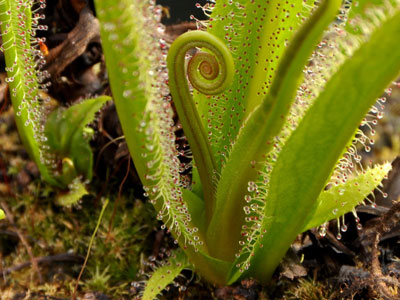Tropical Sundew Care
Get the straight facts from guys who grow and propagate thousands of carnivorous plants every year.

Tropical sundews are as weird and wonderful as carnivorous plants can get. They come in a plethora of shapes, sizes, and colors, and most are surprisingly simple to keep! Below are a few of the most common tropical sundew species you might find in cultivation:






While there are certain characteristics to each variety, the general care is the same for all of them. Use the following guide as a general rule to growing tropical sundews.
Range
Tropical sundews originate from warm climates of the world. South Africa, Australia, New Zealand, and South America are all hotspots for tropical
Drosera. In their native habitat, frost never or rarely occurs, and it never snows. Their preferred habitat is mostly open, wet fields, or cliff-side seeps with thin, weak soil where they can get lots of sunlight.
Where to Grow
Many tropical sundews can be quite adaptable. A sure-fire way to keep them is indoors as a tropical houseplant on a sunny windowsill. If you live in a tropical climate where the temperature rarely drops below 55°F (13°C), you have the option of growing your plants outdoors. Regardless of where you grow them, always protect tropical sundews from excessive wind, harsh sunlight, and especially freezing temperatures.
Sunlight
Some sundews, such as those of the fork-leaf complex, grow best in full sun and warm temperatures. However, most sundews are mountainous species, such as those native to South Africa and South America. So, they like lots of sunlight but mild temperatures. Provide partial sunlight (several hours of direct sunlight with bright filtered light during the day). While it’s important to avoid extremely hot summer sunlight, avoid full shade. Sufficient sunlight is required for your plant to maintain its dewy appearance.
Artificial Lights
If a sunny window is not possible, use LED shop lights with an output of approximately 2,500 lumens or more. Avoid full-spectrum or so-called plant lights. These lights have red and blue diodes which can strain your eyes and do not significantly contribute to your plant’s overall health any more than shop lights with white diodes. Start with the lights approximately 12 inches above the plant. Monitor your plant and adjust the height of the light source if you are not satisfied with its growth. Use an electrical timer to set a 14-hour daylight cycle.
Water
All sundews require mineral-free water. If your tap water is relatively pure (less than 50 parts per million in dissolved minerals), then you can safely water your sundews with it. Otherwise, you can use distilled bottled water. Keep the soil wet at all times. You can do this by setting the plant in small amounts of standing water, up to halfway up the pot.
Soil
Use a soil mixture of 1 part peat moss and 1 part perlite. Never use potting soil, compost or fertilizer; they will kill your plant.
Need more information about growing tropical sundews? Watch our volume 2 playlist and monthly videos. Our digital download, The Ultimate Carnivorous Plant Guide for Beginners, is also a fantastic resource if you are new to growing plants. You will learn how various elements – sunlight, water, soil, and humidity – affect plant growth and how to troubleshoot common plant problems. Visit the website to access these resources.
CLICK HERE to download a printable version of this page.
THE ULTIMATE CARNIVOROUS PLANT GUIDE FOR BEGINNERS
In this downloadable ebook, Jacob Farin, co-owner of Sarracenia Northwest, will show you how to think like a professional carnivorous plant grower and keep your first carnivorous plant alive and healthy. You will learn:
- how sunlight and water affect plant growth.
- what type of soil and pots to use.
- if you really need to shelter your plants from snow and ice.
- how to troubleshoot common plant problems.
If you are new to carnivorous plants or have struggled to keep them alive, this ebook is for you. Download your copy today!
